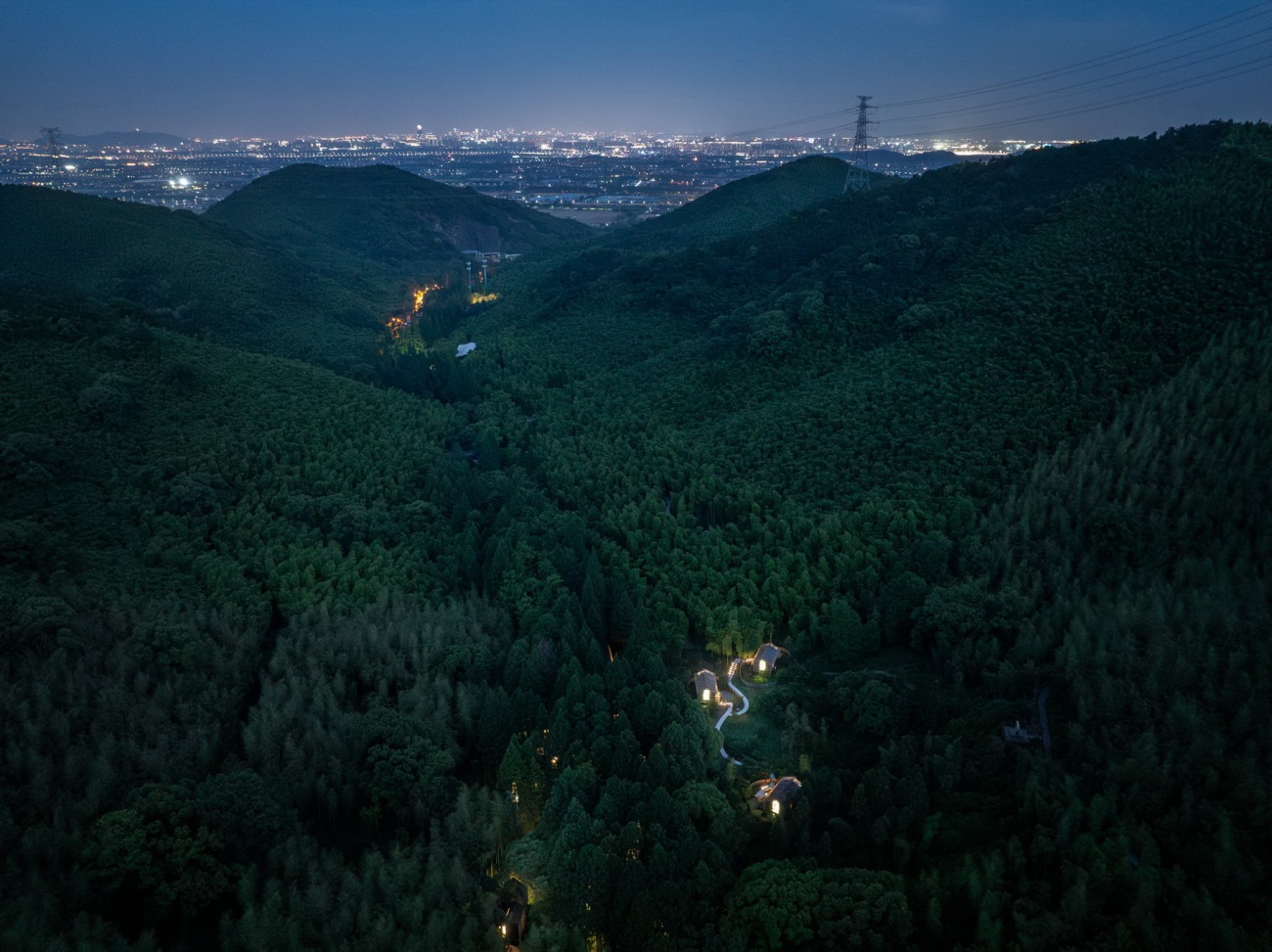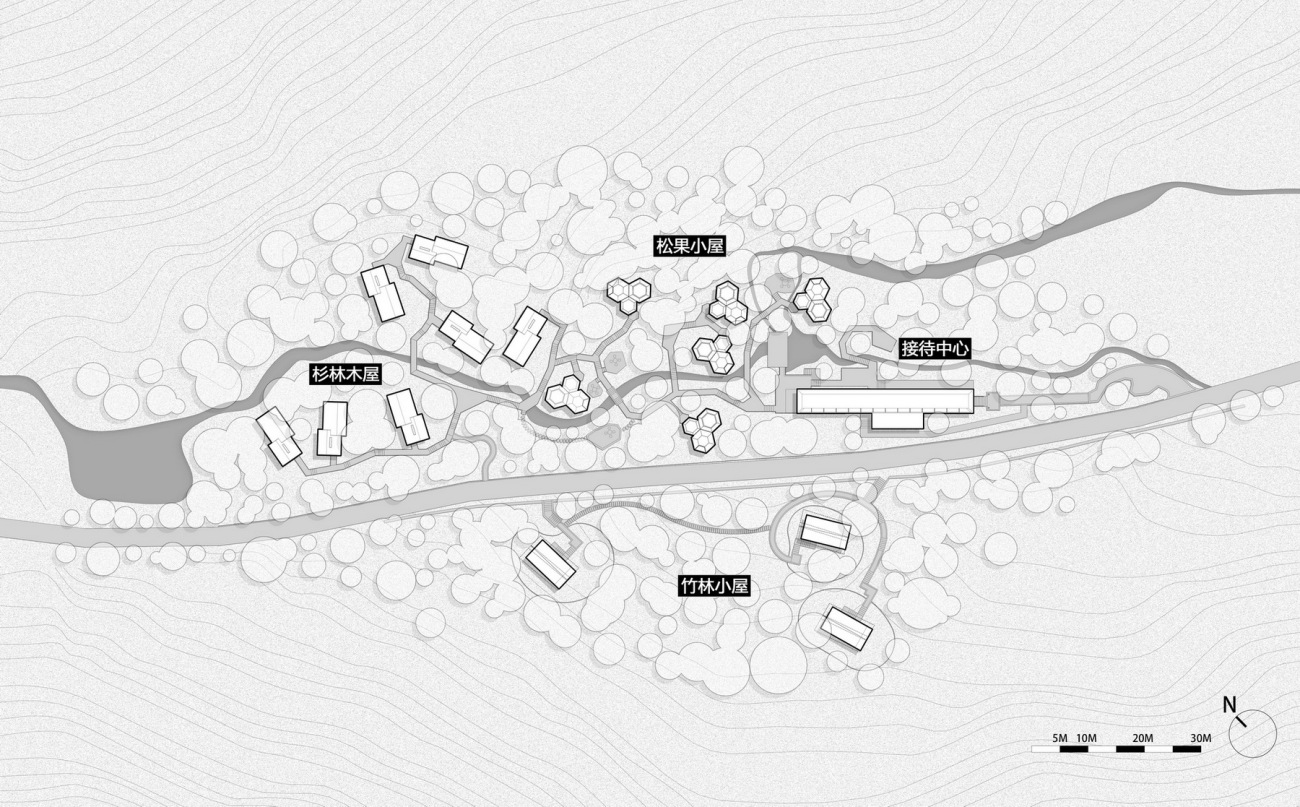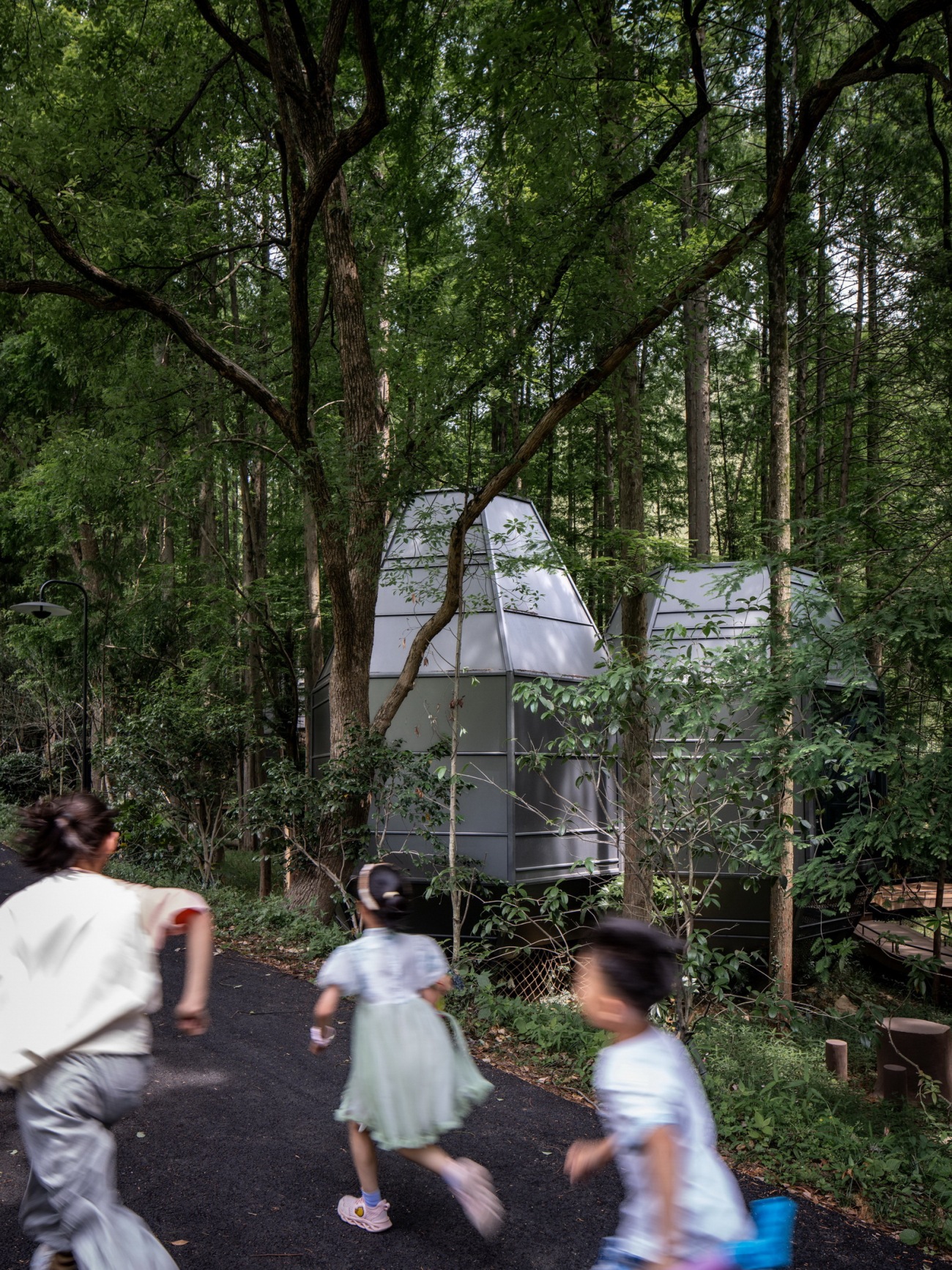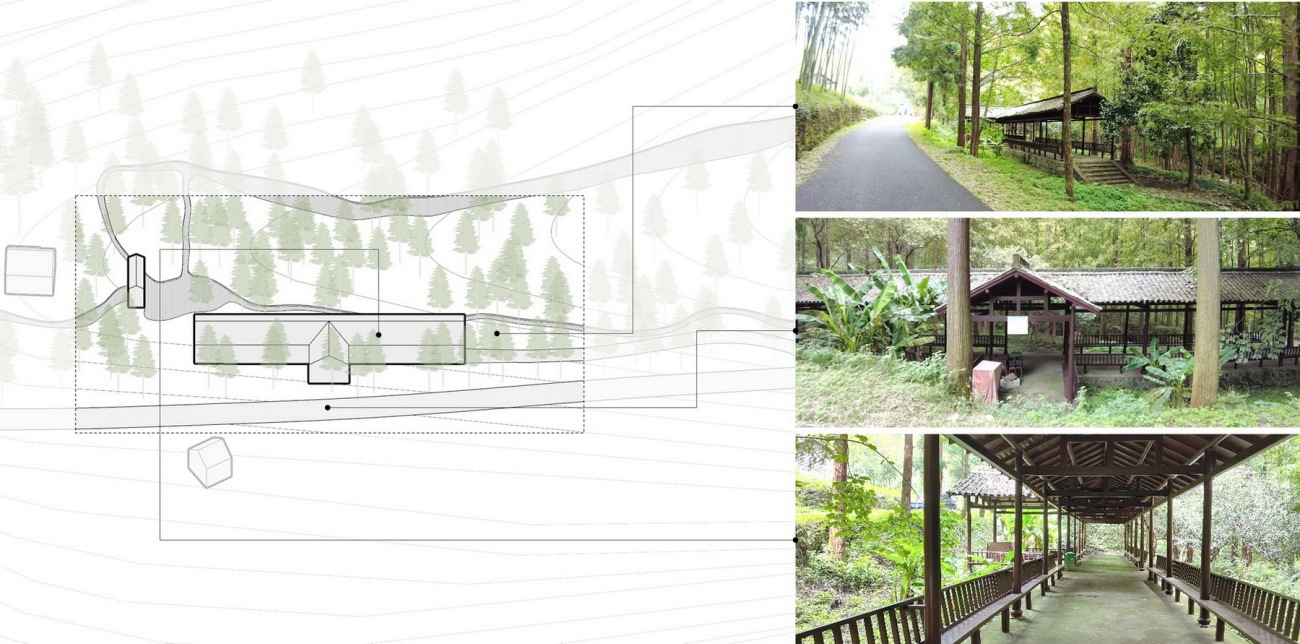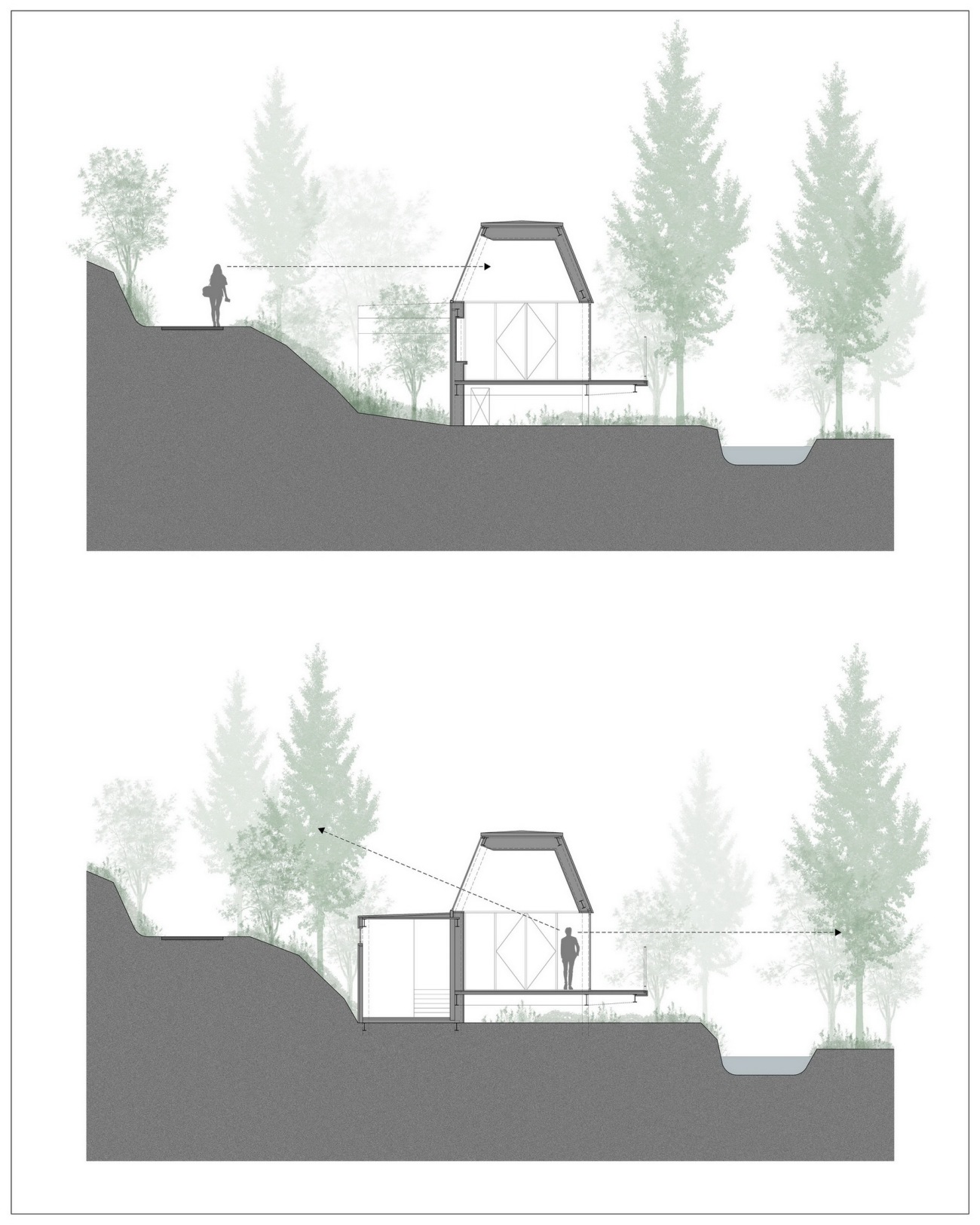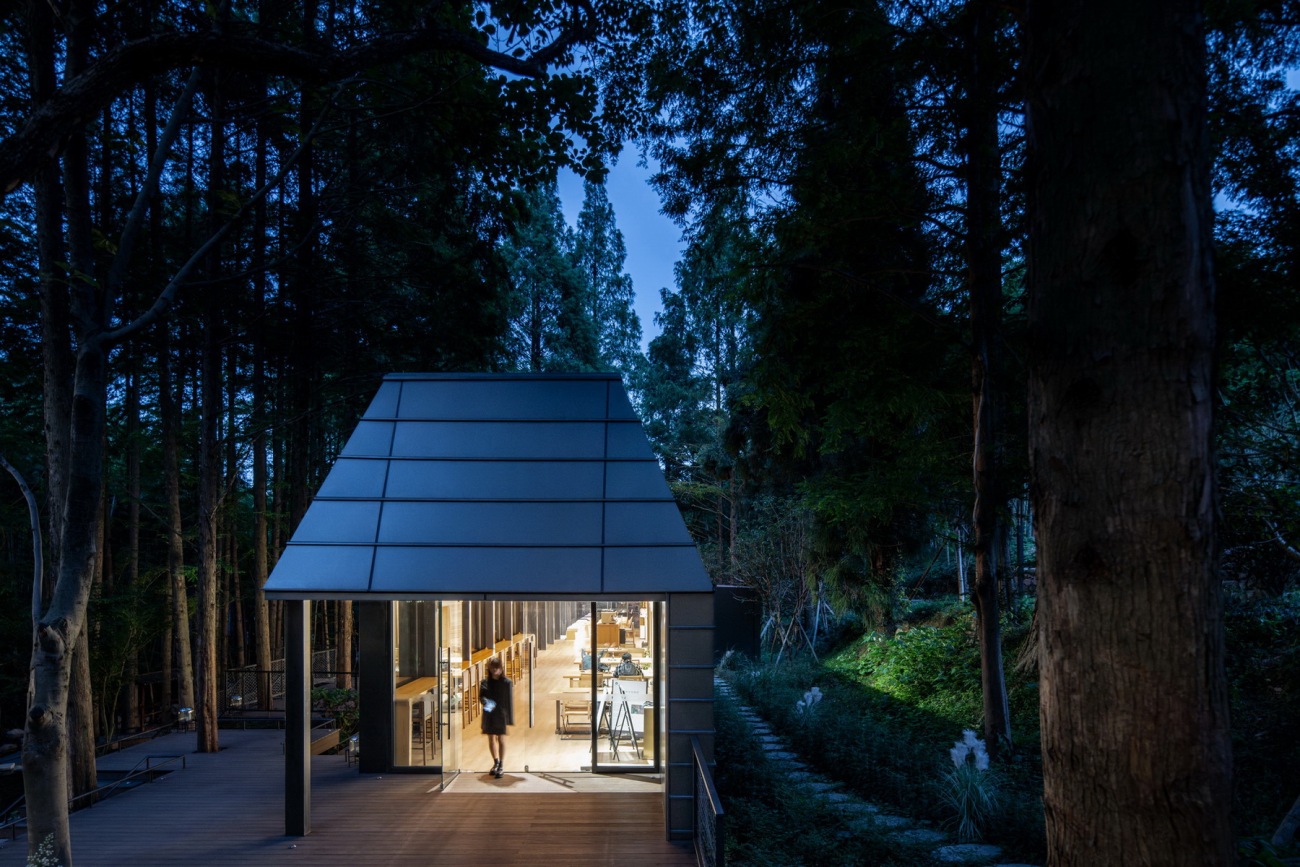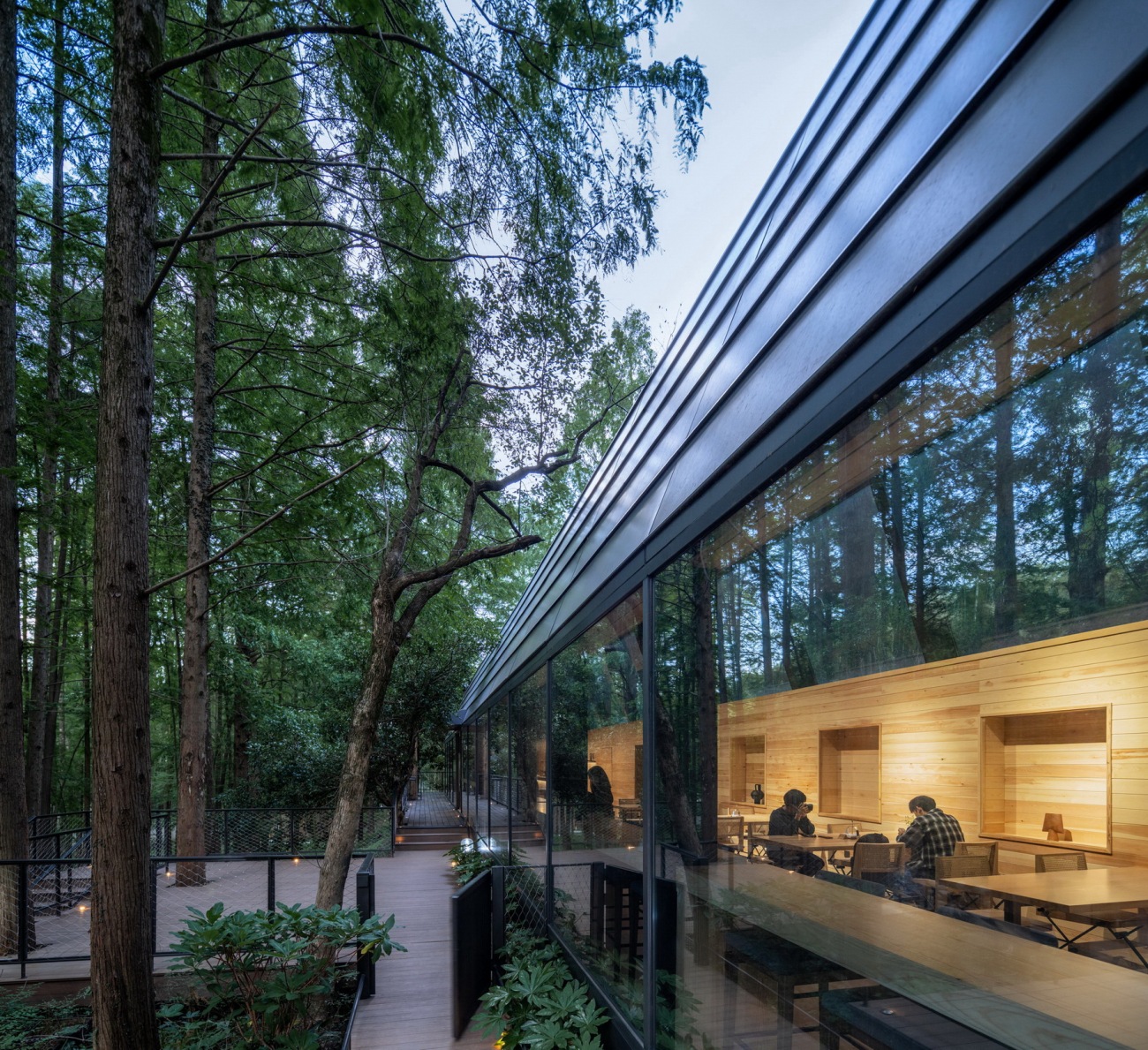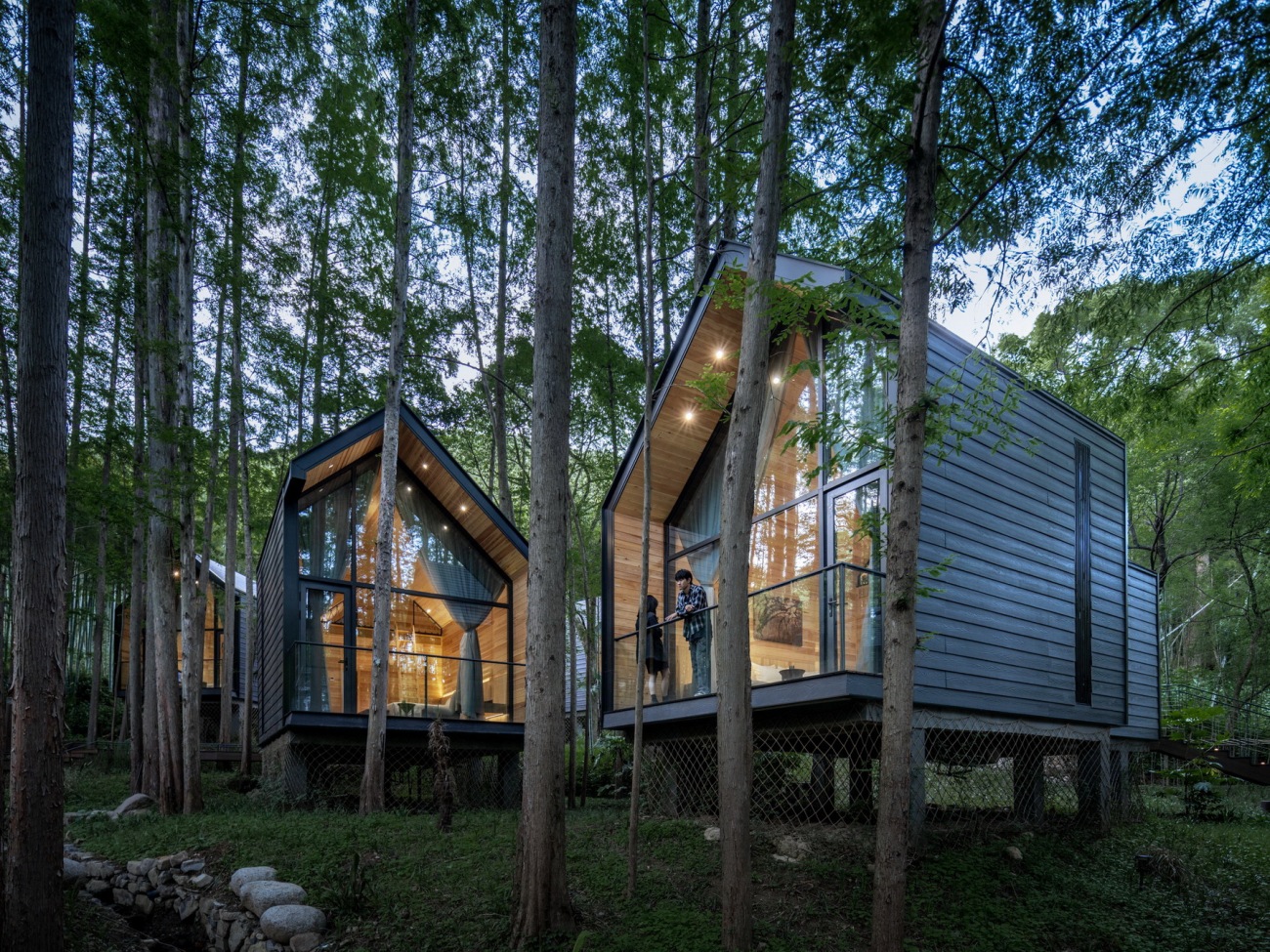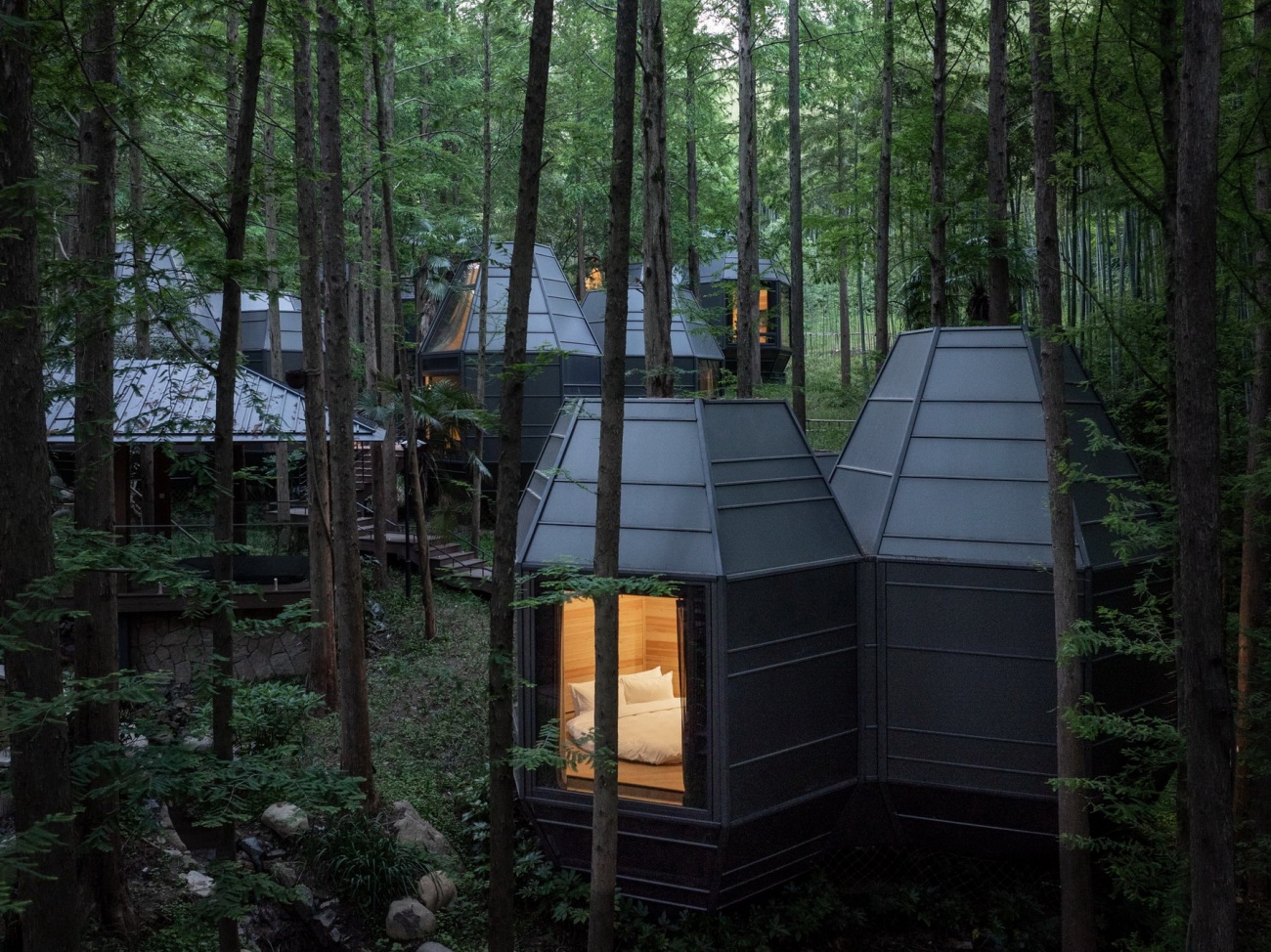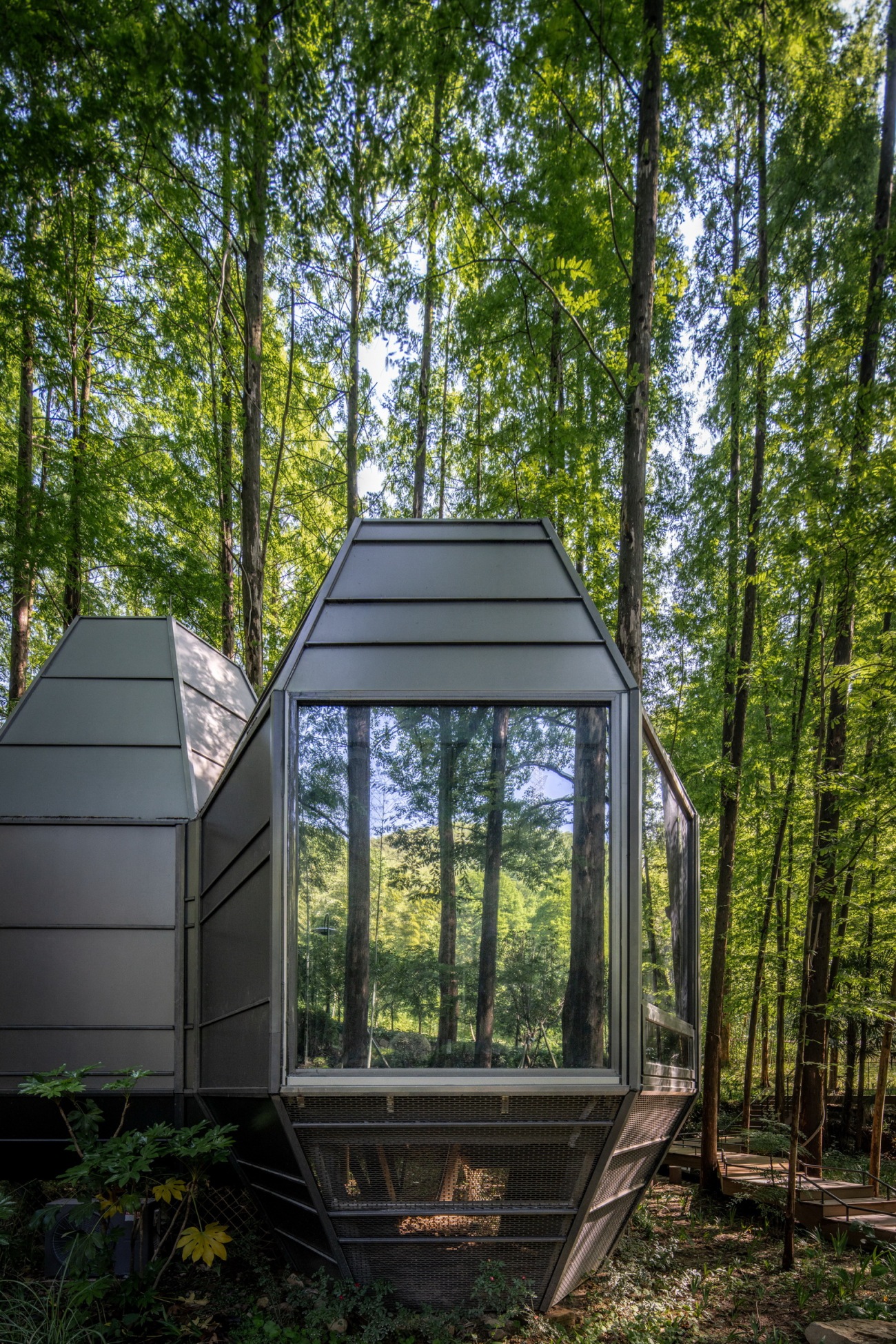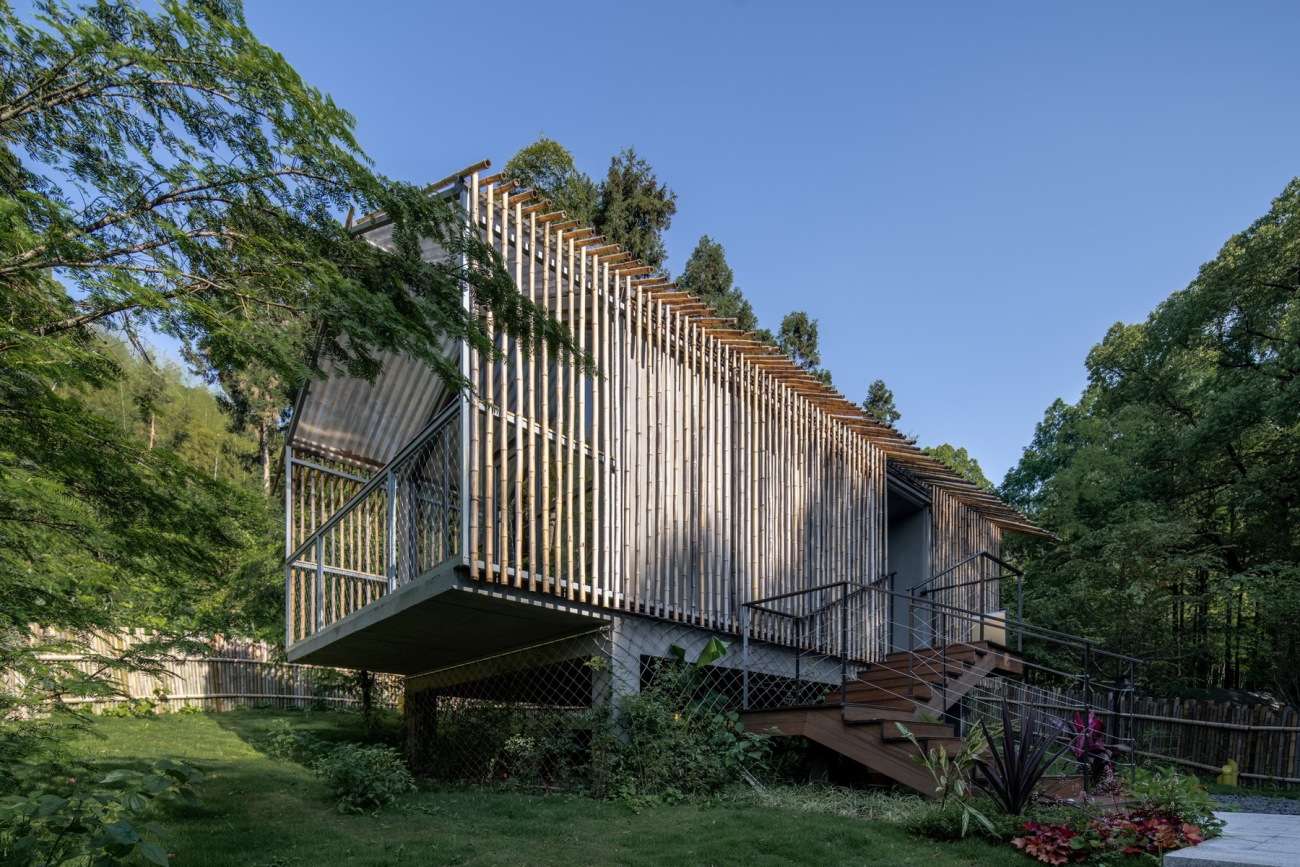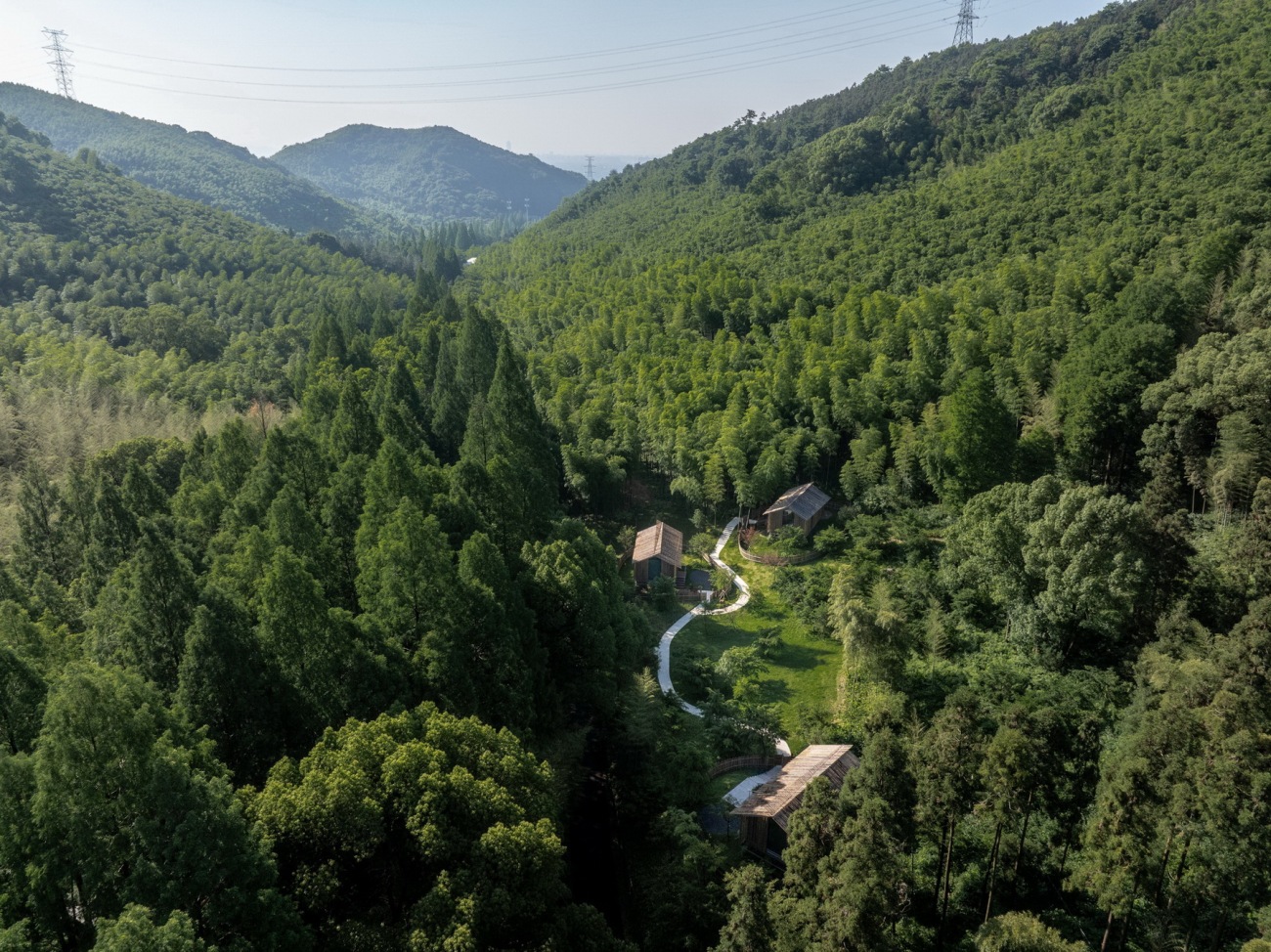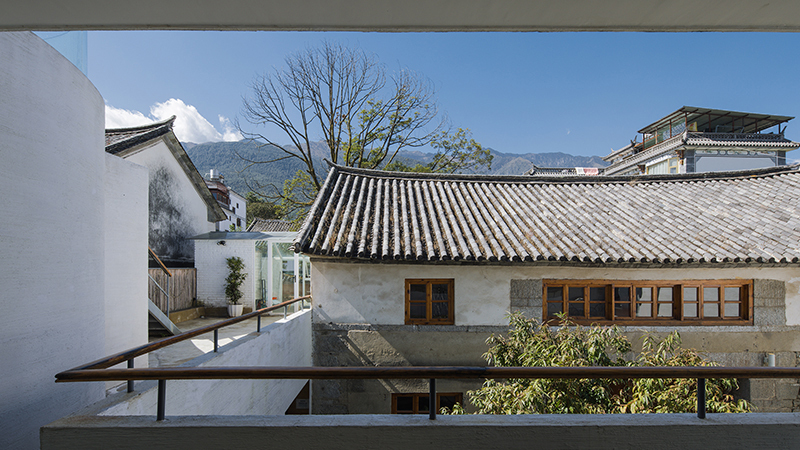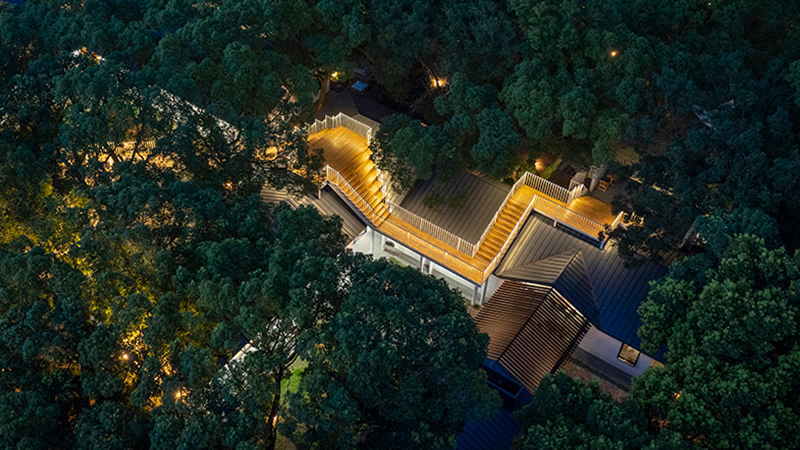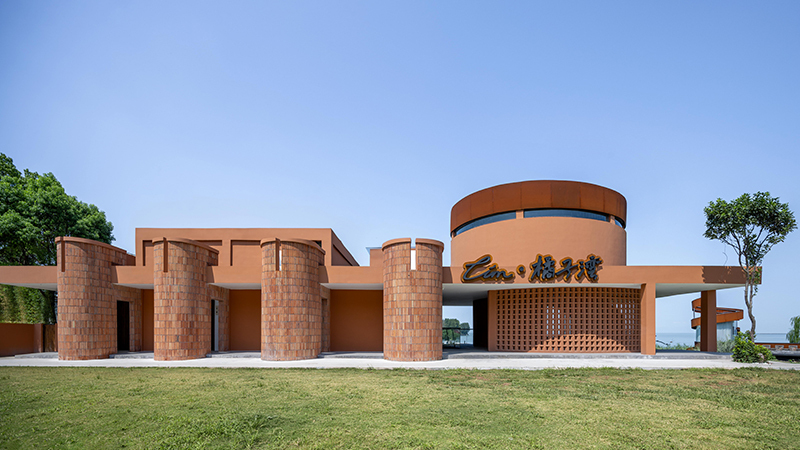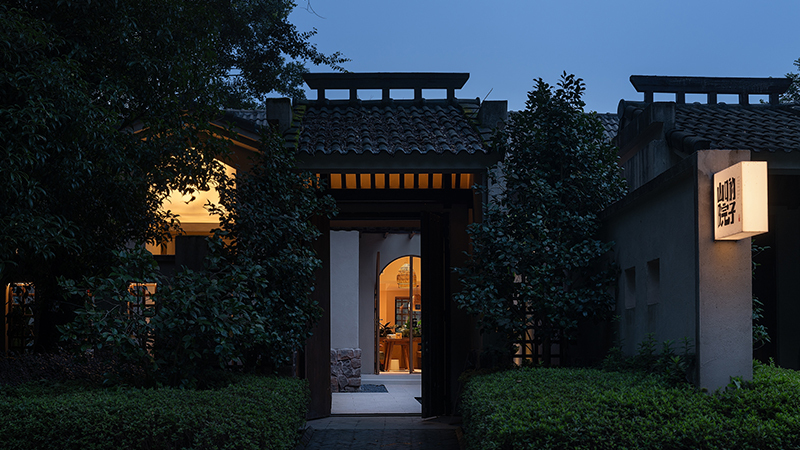“微创式”山地设计:东明山森语
"Minimally Invasive" Upland Design: Dongmingshan Senyu Hotel
东明山森语坐落于东明山森林公园内的一片自然森林中,场地有茂密的水杉与毛竹覆盖。建筑群落由1栋接待中心与3类独栋客房组成。
Dongmingshan Senyu Hotel is located in a natural forest within the Dongmingshan Forest Park, with a dense cover of metasequoia and moso bamboo. The complex consists of a reception center and three types of detached guest rooms.
01 一台“微创手术”— 场地 A "Minimally Invasive Surgery" - Venue
穿越漫长的山径抵达场地,拥抱顺流而下的潺潺小溪和高耸如云的茂密水杉,几栋残破的木屋半掩在林地中。面对这样的场地,设计师坚持原生态和轻介入手法,用建设调整给森林进行一场 “微创式”更新。通过柔化的建筑手法,最大限度地保护林地原貌,努力让设计成果与这片自然山林和谐共生。
Through a long mountain trail, we come to a site embracing a murmuring stream flowing downstream and a dense metasequoia forest towering into the clouds, where a few shabby wooden houses are half-hidden. Faced with such a site, the designers insisted on maintaining the ecology with minimum intervention, and suggested making a "minimally invasive surgery" to the forest. Therefore, they adopted a softened architectural approach to make the design a harmonious part of the natural forest and protect the original appearance of the woodland to the maximum extent.
▽总平图
02 沉浸于“森林情境”— 接待中心 Immersing in "Forest Scene" - Reception Center
接待中心原址的一侧紧邻坡道,另一侧则是茂密的杉林景象。新的设计将原有建筑改为森语的接待中心,满足整体服务需求。
The original site of the reception center was adjacent to a ramp on one side and a dense metasequoia forest on the other. The new design changed the original building into the reception center to meet the overall service needs.
▽接待中心原始照片
▽接待中心剖面
重建后的接待中心,延续了原有建筑的体量和景观感受。南侧下部开长窗,保留原有对水杉林的视野;北侧则将窗改在侧上方,这样既可遮挡坡道,又可将北侧山坡上茂密的毛竹林景观纳入室内。同时上下错开的开窗可以让从道路经过的人视线通畅,可以看到室内的景象,甚至可以透过建筑看到对面的水杉林,视野更加通透。而在室内,两侧长窗为客人提供了杉林与竹林两种不同的自然景观视野。
The rebuilt reception center continues the volume and landscape feeling of the original building. The long windows on the lower part of the south side retain the original view of the metasequoia forest, while on the north side, windows were changed to the side top, which not only can keep out the ramp, but also can look into the dense moso bamboo forest on the north side of the hillside. At the same time, the staggered openings at the top and bottom allow people passing by to have a clear view of the interior, and even to see the opposite side of the metasequoia forest through the building. For guests indoors, the long windows on both sides provide them with two different views of natural landscape, the metasequoia forest and the bamboo forest.
接待中心作为进入森语客房的必经之路,设计希望客人从走向这个建筑,到进入后通过再去往客房的过程都沉浸于森林情境之中。在建筑的形体设计上,顶端收缩的方式与松果木屋形式遥相呼应,也昭示着客人的下一个目的地。无论建筑的室内还是室外,两侧长窗都具有强烈的延续感和指向性,引导客人继续探索这片密林。
The reception center is the only way to the Senyu Room. The designers hope that guests will be immersed in the forest from the moment they walk towards the building to the moment they enter and pass through to the rooms. In terms of the architectural form design, the shrinkage at the top echoes the form of the Pinecone Cabin and points to the next destination of guests. Whether inside or outside the building, the long windows on both sides provide a strong sense of continuity and direction, guiding guests to continue exploring the forest.
03 “模块化”多变空间 — 松果小屋 "Modularization" Variable Space – Pinecone Cabin
谷地中的茂密水杉林是客房场地,原有几栋木屋保存情况较差,决定对其进行拆除,重新打造杉林主题空间。设计过程中,出于环境保护的诉求,必须避免砍伐杉树,维持林地现状。经过多轮尝试最终决定采用松果型的空间形式:底部形态内收并做架空处理,让出地面空间同时也可适应不平整的地形条件,顶部内收与水杉树向上生长的形式相呼应,中段使用空间垂直处理,保证空间的使用功能。整体建筑形态宛如森林中的一枚松果,与自然环境巧妙融合在一起。
The dense metasequoia forest in the valley is the site for guest rooms. The original several wooden houses were very shabby, so it was decided to remove them and recreate a metasequoia forest theme space. For the sake of environmental protection, it is required to avoid cutting down the metasequoia trees and maintain the status quo of the woodland to the greatest extent. After many rounds of attempts, we finally decided to adopt a pinecone-type space form, i.e. to inwardly retract and elevate the bottom to allow some ground space and adapt to uneven terrain conditions at the same time, while also to inwardly retract the top to echo with the upward growth of the metasequoia trees, as for the middle part, the space will be vertically treated to ensure the functionality of the space. Overall, the building looks like a pine cone in the forest, which is skillfully integrated with the natural environment.
为了适应多变的水杉林场地,建筑单体决定采用模块组合的形式。以六边型的平面为基础,拓展出各种方向的可能性,再依据树木分布情况,自由组合出多种形式的客房户型。这种模块化的单元组合模式适应多变的空间条件的同时,高效利用了狭窄的林间空地。
In order to adapt to the changing site of the metasequoia forest, each building adopts a modular assembly form. Based on a hexagonal plane , the design expanded the possibilities of various directions, and then based on the distribution of trees, various types of guest rooms are assembled. This modular assembly form of buildings not only adapts to the changing spatial conditions but also can efficiently utilize the narrow forest clearings.
▽适应场地的松果小屋
为了能最大程度的减少施工对环境的破坏,建筑采用装配式的施工方式。六边梭形的体块可拆分为六个尺度相同的立面,通过控制形体的尺寸控制预制构件的尺寸,满足预制要求。设计采用预制构件的装配式钢结构,现场拼装,减少现场工作量。除了建筑主体外,室内空间也进行了标准化设计,依据不同的模块功能定制室内家具配置。室内空间在满足舒适性外,也让体验感不失趣味性。
In order to minimize the damage to the environment caused by construction, the building is constructed by assembling prefabricated components. The hexagonal shuttle-shaped main body is split into six facades of the same size, and the size of each prefabricated component is controlled to meet the prefabrication requirements. In this design, prefabricated components with prefabricated steel structure are assembled on site to reduce the onsite workload. In addition to the main body of the building, the interior space also has a standardized design. On the basis of each different modular function, interior furniture is customized, which not only provides a comfort interior space, but also provides guests with interesting experience.
▽松果小屋实体模型
 | 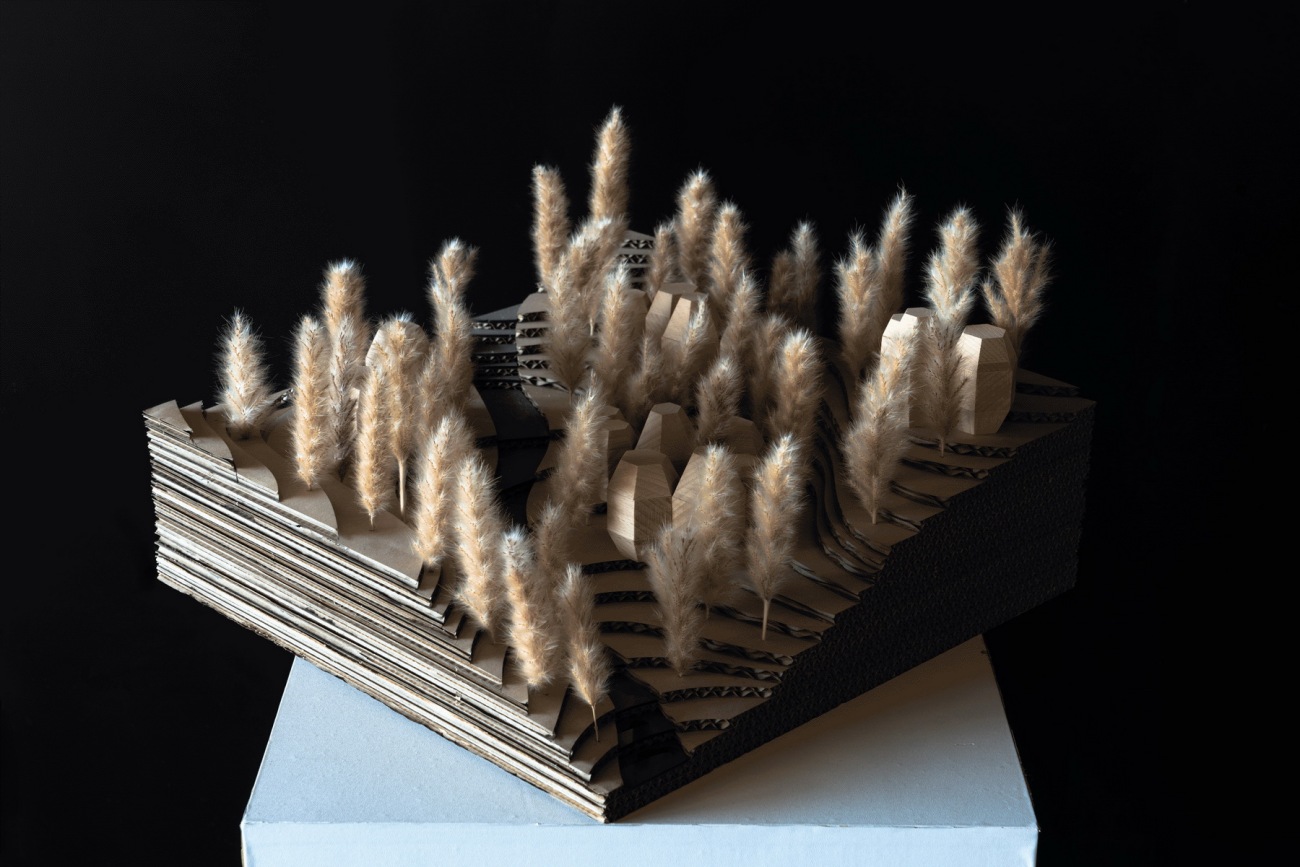 |
 |  |
04 “全视野”内外空间 — 杉林小屋 "Full View" Interior and Exterior Space - Metasequoia Wood Cottage
杉林木屋与松果小屋同样以杉林为设计场所,是设计师对于茂密林木空间的另一种设计思考。建筑形式上与松果小屋同样采用了吊脚楼的传统形制,通过抬离地面,尽量小的破坏场地,同时吊脚楼也能更好地通风缓解山地湿气重等问题,离地也能一定程度上缓解山地蛇虫等对居住体验的影响。建筑主体则采用了双坡屋顶的形式,高耸向上的体量与周边挺拔的水杉气质相契合,深色的木纹外立面则在材质和质感上更接近水杉碧色的整体色调。
Same as the Pinecone Cabin, the Metasequoia Wood Cottage is also built in the metasequoia woods, which is another design thinking of the designer for the dense forest space. The architectural form is also the same as that of the Pinecone Cabin, both of which adopt the traditional form of a "stilted building", in which the ground is lifted off to minimize the damage to the site, while at the same time, the building can provide better ventilation to alleviate the problems of heavy moisture in the mountainous area; moreover, lifting off the ground can also prevent snakes and insects from affecting guests' living experience to a certain extent. The main body of the building adopts a double-sloped roof, the soaring volume of which perfect matches the upright temperament of metasequoia, while the dark wood-grain facade echoes in material and texture to the overall color tone of the turquoise metasequoia.
在略显紧凑的原始木屋场地中,设计师注重朝向的选择,让每一间木屋都有独享的视野朝向,整体形成组团又彼此互不干扰。室内空间部分,设计师保留了主要空间的整层通高,让住客能通过天窗感受到阳光与树影的变化,入口区域则设置了局部二层阁楼,增加了可变空间,为功能拓展留下余地。内饰面整体采用松木,明亮的木色给人更多居家的温馨感,同时也与周边水杉环境更为契合,紧邻居住空间设置了一方阳台,结合周边的天然环境,在这一片天然的环境中,打造一方小小的平台,轻柔的拥抱大自然。
In the slightly compact site of the original chalets, the designer attached great importance to the orientation, so that each chalet can have an exclusive view while together they form a group without interfering with each other. For the interior, the designer retained the full height of the main space, so that the guests can feel the changes of the sunlight and the shadows of trees through the skylight. At the entrance area, a partial second floor attic is set up, which increases the variable space and leaves room for functional expansion. The interior finishes are made of pine wood, the bright color of which gives people a feeling of home, which also fits perfectly with the surrounding metasequoia environment. Adjacent to the living space, there is a balcony, a small platform for guests to embrace nature.
05 “现代化”竹译表皮 — 竹林小屋 "Modernization" Bamboo Element – A Bamboo Hut
在水杉林的对面是一片茂密的毛竹林,设计将原有的三栋小房子以竹林主题原址重建。考虑到整体的造价限制,建筑采用了最简单的方盒子双坡顶形式与混凝土结构,形体上没有做复杂的设计。但是在立面上化用了场地原有的竹元素,设计了编织的竹幕墙立面。同时将钢架结构外露,为后期竹幕墙形式的变化预留可能性。
Opposite to the metasequoia forest is a dense moso bamboo forest. The design rebuilt the original three small houses in the same location with the theme of bamboo forest. Taking into account the overall cost constraints, the designer adopted the simplest form of a square box with double sloped roof and concrete structure for the building, without complicated design in the form, but utilized the original bamboo element of the site and designed a woven bamboo curtain wall facade. At the same time, the steel frame structure is exposed to allow future changes (if any) to the form of the bamboo curtain wall.
结语 Concluding Remarks
在整体营建过程中,为保证建筑完美契合于密林,设计师多次实地勘探,确认每一棵树的位置,同时在施工过程中根据实际情况即时调整方案,做到不动一棵树,尊重场地最原始的性格,让空间与自然和谐共生。
To ensure that the buildings fit perfectly in the dense forest, the designers have made repeated on-site explorations to confirm the location of each tree, and at the same time, adjusted the program immediately according to the actual situation during the construction process, so as to keep the site as it is to the largest extent and let the space and nature coexist in a harmonious way without removing one tree.
在丛山密林,清泉流水中,在清晨鸟鸣,树影斑驳中,寻一所远离尘世的山居,筑一方静谧清心的幽境。希望来到木屋旅社的每一位旅客,都能够从山野自然中,寻找到属于自己的灵魂居所。
Besides the clear streams in the dense forests and around the morning singing birds behind the dappled shadows of trees, we built a mountain house far away from the urban hustle and bustle, a perfect place for you to rest your heart in tranquil and peace. We hope that every visitor to the Chalet Hostel can find a home to his or her own soul in the mountains and nature.
项目信息 Project Information
项目地点:浙江杭州
Project Location: Hangzhou, Zhejiang
建筑面积:1300 平方米
Construction Area: 1,300 square meters
设计时间:2020年
Time of Design: 2020
完成时间:2024年
Time of Completion: 2024
建筑设计:GLA建筑设计
Architectural Design: GLA Design
其他参与者 / 合作者 Other participants / Collaborator
室内设计:VBD 中置华优设计集团
Interior Design: VBD Design Group
景观设计:杭州蓝绿双城景观设计工程管理有限公司
Landscape Design: Hangzhou Smart City Smile City Landscape Design Engineering Management Co., Ltd.
幕墙设计:浙江省武林建筑装饰集团有限公司
Curtain Wall Design: Zhejiang Wulin Construction Decoration Group Co., Ltd.
建设单位:杭州东明山森林公园有限公司
Construction Unit: Hangzhou Dongmingshan Forest Park Co., Ltd.
施工单位:浙江振丰建设有限公司
Construction Unit: Zhejiang Zhenfeng Construction Co., Ltd.
建筑摄影:陈曦工作室
Architectural Photography: Chen Xi Studio
更新日期:2024-10-22 16:58:27
非常感谢 GLA建筑设计 带来的精彩项目, 查阅更多Appreciations towards GLA Design for sharing wonderful work on hhlloo. Click to see more works!

